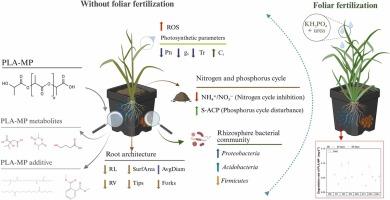From biodegradation to biohazard: polylactic acid microplastics induced rice growth inhibition in agroecosystems
IF 11.3
1区 环境科学与生态学
Q1 ENGINEERING, ENVIRONMENTAL
引用次数: 0
Abstract
The increasing use of biodegradable plastics necessitates critical evaluation of their environmental safety. This study investigated the effects of polylactic acid microplastics (PLA-MPs, 0.1–2.5% w/w) on rice–soil systems using controlled pot experiments integrated with enzymatic assays, rhizosphere bacterial profiling, and non-target analysis of degradation products. PLA-MPs exposure inhibited rice growth by reducing photosynthetic efficiency and root development, which was associated with decreased nitrogen availability (30–60% reduction in NH+4/NO-3-N), altered phosphorus levels, and reduced microbial α-diversity. Foliar fertilization alleviated phytotoxic effects by improving antioxidant responses and nutrient uptake. Non-target screening identified lactic acid derivatives as dominant degradation products, with limited long-term persistence. The degradation rate of PLA-MPs was estimated at 0.065 mg·d⁻¹ under soil conditions. These results indicate that PLA-MPs, despite their biodegradable nature, can adversely affect soil nutrient cycling and crop performance. These findings emphasize the need to re-evaluate biodegradable plastic use in agriculture and promote integrated mitigation strategies to reduce microplastic-induced stress and support sustainable soil–plant systems.

从生物降解到生物危害:聚乳酸微塑料在农业生态系统中诱导水稻生长抑制
生物可降解塑料的使用越来越多,需要对其环境安全进行严格的评估。本研究通过对照盆栽试验研究了聚乳酸微塑料(PLA-MPs, 0.1-2.5% w/w)对水稻-土壤系统的影响,并结合酶分析、根际细菌谱分析和降解产物的非目标分析。PLA-MPs暴露通过降低光合效率和根系发育来抑制水稻生长,这与氮素有效性降低(nh4 /NO-3-N降低30-60%)、磷水平改变和微生物α多样性降低有关。叶面施肥通过提高抗氧化反应和养分吸收来缓解植物毒性效应。非靶标筛选鉴定乳酸衍生物是主要的降解产物,具有有限的长期持久性。在土壤条件下,PLA-MPs的降解率估计为0.065 mg·d⁻¹。这些结果表明,尽管PLA-MPs具有可生物降解的性质,但它会对土壤养分循环和作物生产产生不利影响。这些发现强调有必要重新评估农业中可生物降解塑料的使用,并促进综合缓解战略,以减少微塑料引起的压力,并支持可持续的土壤-植物系统。
本文章由计算机程序翻译,如有差异,请以英文原文为准。
求助全文
约1分钟内获得全文
求助全文
来源期刊

Journal of Hazardous Materials
工程技术-工程:环境
CiteScore
25.40
自引率
5.90%
发文量
3059
审稿时长
58 days
期刊介绍:
The Journal of Hazardous Materials serves as a global platform for promoting cutting-edge research in the field of Environmental Science and Engineering. Our publication features a wide range of articles, including full-length research papers, review articles, and perspectives, with the aim of enhancing our understanding of the dangers and risks associated with various materials concerning public health and the environment. It is important to note that the term "environmental contaminants" refers specifically to substances that pose hazardous effects through contamination, while excluding those that do not have such impacts on the environment or human health. Moreover, we emphasize the distinction between wastes and hazardous materials in order to provide further clarity on the scope of the journal. We have a keen interest in exploring specific compounds and microbial agents that have adverse effects on the environment.
 求助内容:
求助内容: 应助结果提醒方式:
应助结果提醒方式:


